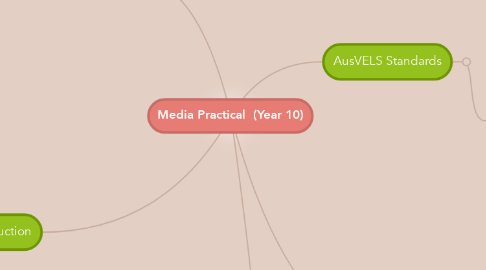
1. Pre-production
1.1. Scriptwriting
1.1.1. Celtx: Allows for sharing, online collaboration, and comment.
1.1.1.1. This is not an example of technological augmentation in the classroom. Rather, it allows for students to collaborate and share their work when not in school. This avoids logistical issues that previously existed such as organising times for groups to meet outside school (SAMR).
1.2. Storyboarding
1.2.1. Storyboard That! Allows for the use of pre-constructed templates and images
1.2.1.1. In allowing for pre-created images, it augments the creation of storyboards by students. Instead of focusing on the quality of their drawings, they are able to use the database of images to map out their ideas more efficiently (SAMR)
1.2.2. Storyboard Tutorial. Possibly for home use.
1.2.2.1. The advent of YouTube allows for an online environment in which students can access a multitude of tutorials on a host of topics. This allows the teacher to provide their usual generalised lesson, however, on top of this, students are able to learn about various specialty areas. In this case, students are given an in depth understanding of storyboard technicalities. This acts as a modification of the learning process itself as the learning has become decentralised, and not reliant entirely on teacher-directed learning (SAMR).
2. Production
2.1. Sharing
2.1.1. Intra
2.1.1.1. Padlet:
2.1.1.1.1. Padlet allows for students to view, comment, and share videos within a school setting in a safe, and moderated environment. In this context, it would act as an extension (augmentation) of the learning environment (SAMR).
2.1.2. Inter
2.1.2.1. Vimeo student films:
2.1.2.1.1. Students are able to upload their finished products to this site in order to reach a wider audience. Not only does it allow for students to view each others works, those in the wider community can also comment upon the creations. In a way, it allows for extended feedback for the student from external sources not previously reachable. It is a good example of technological redefinition.
3. Post-Production
3.1. Editing
3.1.1. Sony Vegas
3.1.1.1. Editing software such as Sony Vegas have redefined the ways in which films can be cut, and edited. They allow for extreme flexibility, and the ability to rescind decision. As such, Sony Vegas is a perfect tool in which students can make mistakes with minimal consequences. The only downside of such software is that it is often costly. The advent of such technology has redefined the way in which students can edit their films. The minutia that now exists in sound editing is a direct result of the technology that is a available (SAMR).
4. Associations + Extra Resources for Teachers
4.1. ATOM (Australian Teachers of Media)
4.1.1. Screen Education Magazine
4.1.2. Professional Development
4.1.3. Screenings
4.2. Common Sense Media
4.2.1. Education Blog
4.2.1.1. 'Q&A: How One Teacher Is Integrating Tech on a Tight Budget'
